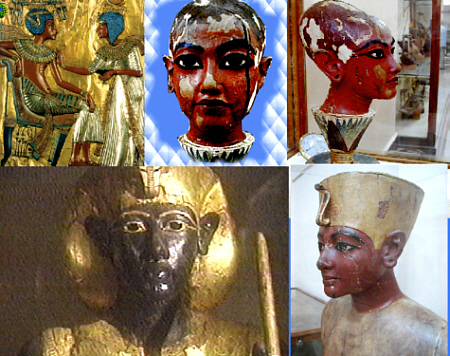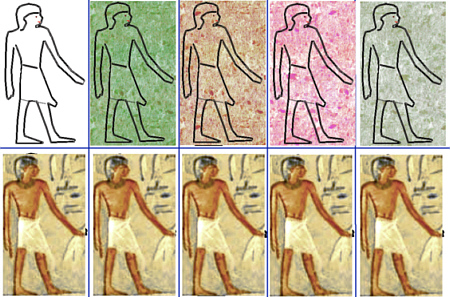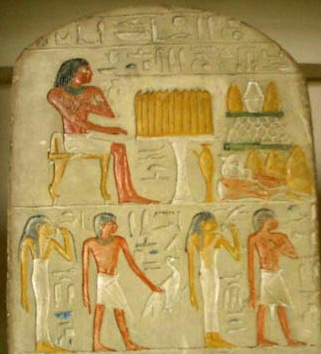
To E-mail this web page
after it is completely loaded
Left click on File
Left click on Send
Left click on Page by E-mail
==================================================
If I remember right all of these statues or paintings are
supposed to be images of Tut.
Paint Flaking
When you see paint flaking from a wall or from a statue, you can think.. OK,
where the paint is flaked off you can see the original color of the canvas
before the artist chose these colors to represent the original person.
Note, all the images of Tut are dark reddish brown, to almost black.
You can see where the paint is flaking off Tut's statute that the original
canvas (material it was made of) was almost white.
Tut's tomb was full of images of him... and every time the artist chose a
color to paint his face, they chose a dark brownish red to black.

Canvas = natural color of the clay or stone an image was painted on.
DRAWING vs PAINTING
I am not what actual terms apply in art, but the differences
I speak of here are like the stick men we drew in grade school.. using a
pencil to draw the general outline of a person or animal.. all black lead on a
single color back ground.
Later we might of used red to color the lips and blue to color the eye balls,
but the color of the flesh was not filled in and remained the color of our
canvas (what ever we were drawing on).
Below I have an actual painting of some Egyptian guy in a tomb and above I
have some different color stones. Above is the what the drawing would have
looked like on that particular color stone.

Below is what it would have looked like if it was painted
(instead of drawn) on those different color stones.
If it were painted on a green stone, the guys skin would have been brown.
If it were painted on a tan stone, the guys skin would have been brown.
If it were painted on a pink stone, the guys skin would have been brown.
If it were painted on a gray stone, the guys skin would have been brown.
But if it were a drawing, the skin would take on
the color of the stone.. green, tan, pink or gray.
I suppose people were always vain like we are today, they wanted pictures to
reflect their own image. What color do you figure Tut was by the statues,
pictures created after his own image?
No matter what colors of skin you think ancient Egyptians may have, go to the
tombs, count any pictures that remain in tact and tell us what % of that tomb
paintings were of black / brown skin people.
Don't pick just a couple to through the manifest of all recorded paintings or
sculptures and write what % ________ of them were of
brown/black skin people.
Drawings do NOT reflect the artist view of the
subject's skins, but when they filled in the skin color with paintings
and went to the trouble of selecting the colors for the skin of the models,
why do you suppose they selected brown/black for that %_________
of the images they painted?
Do you suppose thousands of the paintings/statues they painted were actually
of white people and they were pulling a joke? We will paint Tut and all of
these Egyptians brown/black, then in 3,000 to 5,000 years from today when
future generations enter these tombs, they will think these Egyptians were
blacks?
We will look at that the possible reasons are why the Egyptian artist selected
brown/black to paint the thousands of faces found in the burial places of
Egypt.
Below is the original picture I got my model for the picture above.

Note the guy and the girl are different colors. Unless the artist were trying to reflect the skin tones of his subject, why would he bother to paint them different colors?
It appears Anny Egyptian stayed home during the week
watching Ophra and Eddy Egyptian was working outside on the pyramids in the
sun. No matter what the cause, the artist intentionally painted them different
hues of brown.
Instead of using the skin color of the milk face "Jews" of Europe,
what would make the ancient artist choose shades of brown to almost black, to
reflect the colors of the skin of the ancient Egyptians?
Back to the Oasis
zendz